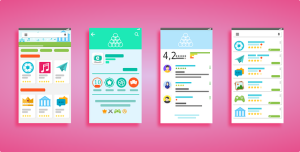In today's digital era, high-quality User Interface (UI) and User Experience (UX) design is essential for online success. Contrary to belief, exceptional UI/UX design doesn't have to be expensive. Affordable UI/UX design leverages open-source software, remote collaboration, modular approaches, and streamlined methodologies to deliver seamless experiences at lower costs. Tools like Figma and Sketch, online UI kits, and open-source communities democratize the process for businesses of all sizes. Effective UI design requires user research, combining qualitative insights with quantitative data. Successful organizations have implemented affordable UI/UX practices, proving quality doesn't require significant cost.
In today’s digital landscape, exceptional user experiences are non-negotiable, yet quality UI/UX design can come with a hefty price tag. Discover how you can unlock budget-friendly solutions without sacrificing excellence. This comprehensive guide explores various strategies to make UI/UX design more accessible, from cost-cutting techniques and efficient tools to outsourcing options and user research methods. By implementing these affordable practices, businesses can create stunning interfaces that meet user needs effectively.
Understanding Affordable UI/UX Design: Unlocking Budget-Friendly Solutions

In today’s digital landscape, high-quality User Interface (UI) and User Experience (UX) design is essential for any successful online venture. However, it’s a common misconception that achieving exceptional UI/UX design comes with a hefty price tag. Affordable UI/UX design isn’t about sacrificing quality; instead, it’s about finding innovative solutions that align with budget constraints without compromising user satisfaction. This approach involves strategic planning, leveraging readily available tools and resources, and adopting streamlined methodologies to deliver seamless digital experiences.
By embracing accessible design principles, open-source software, and collaborative remote work practices, designers can create intuitive interfaces and engaging user journeys at a fraction of traditional costs. It’s about understanding that affordability doesn’t equate to compromise; it’s about unlocking creative solutions that not only meet but exceed expectations, ensuring your project stands out in a crowded digital market without breaking the bank.
The Role of UI Design in Modern Digital Experiences

In today’s digital landscape, user interface (UI) design plays a pivotal role in shaping modern digital experiences. It serves as the bridge between complex technology and the everyday user, ensuring that applications and websites are intuitive, accessible, and visually appealing. A well-designed UI not only enhances user satisfaction but also fosters engagement and loyalty, driving business growth and success.
UI design is more than just aesthetics; it involves careful consideration of user needs, behaviors, and preferences. By prioritizing usability and accessibility, designers create interfaces that simplify interactions, reduce friction, and enable users to accomplish their tasks efficiently. This, in turn, enhances the overall user experience (UX), making digital products not just functional but truly enjoyable to use.
Strategies for Reducing Costs Without Compromising Quality

In the pursuit of affordable UI/UX design, it’s essential to implement strategies that reduce costs without sacrificing quality. One effective approach is leveraging open-source tools and resources, which offer a wide array of high-quality options at no or low cost. These tools can streamline the design process, from wireframing to prototyping, without breaking the bank. Additionally, adopting a modular design philosophy allows designers to create scalable and flexible interfaces using reusable components, minimizing redundant effort and resource allocation.
Another key strategy is embracing agile methodologies. By iteratively refining designs based on user feedback, teams can avoid building unnecessary features or complexities, thus reducing overall costs. Cloud-based collaboration tools facilitate efficient remote work, cutting down on travel expenses and physical design assets. Moreover, focusing on minimalism and simplicity in UI design can significantly lower development costs by simplifying the coding process and enhancing user experience through intuitive interfaces.
Tools and Resources for Efficient UI/UX Development

In today’s digital landscape, creating stunning and user-friendly interfaces doesn’t always require a hefty budget. A variety of tools and resources are available that democratize UI/UX design, making it accessible to businesses of all sizes. From intuitive design software to open-source components, these tools offer efficient workflows and cost-effective solutions for building beautiful interfaces. For instance, platforms like Figma and Sketch allow designers to collaborate in real-time, streamline the prototyping process, and ensure consistent designs across devices.
Additionally, extensive libraries of UI kits and pre-built components are readily accessible online. These resources save valuable time by providing ready-to-use elements that can be easily integrated into projects, reducing the need for designers to start from scratch. Open-source communities also contribute to a rich pool of free tools and plugins, further enhancing the efficiency and affordability of UI development.
Outsourcing vs. In-House: Finding the Right Balance for Your Project

When considering affordable UI/UX design solutions, one of the key decisions facing businesses is whether to outsource or establish an in-house team. Outsourcing allows for access to a global talent pool and cost-effective solutions, especially for complex projects or specific expertise needed. It offers flexibility and the ability to scale resources up or down based on project demands. However, it may result in less control over the design process and potential communication barriers.
In-house UI design teams provide direct control and a deeper understanding of your brand’s identity. They ensure consistent design language across projects and facilitate easier collaboration with other internal departments. Nevertheless, building and maintaining an in-house team can be more expensive and may not always guarantee the latest design skills or diverse perspectives. Balancing these options depends on project scope, budget, desired control, and the long-term goals of your brand’s UI design strategy.
User Research Methods to Optimize Your Design Process

User research is an indispensable step in the UI design process, ensuring that the final product meets user needs and expectations. Start by understanding your target audience; conduct interviews, surveys, or focus groups to gather insights into their behaviors, preferences, and pain points. This qualitative data provides a human-centric foundation for your design decisions.
Quantitative methods, such as usability testing and analytics tracking, offer tangible metrics on how users interact with your interface. By observing user behavior, you can pinpoint issues, improve navigation, and optimize the overall user experience. Combining these research techniques allows for informed UI design choices that resonate with your audience.
Case Studies: Successful Implementation of Affordable UI/UX Practices

In recent years, many organizations have successfully implemented affordable UI/UX practices, demonstrating that excellent user experiences don’t always come with a hefty price tag. Case studies from startups to established enterprises show that strategic design choices, user-centric approaches, and innovative tools can drastically reduce UI/UX design costs without sacrificing quality. For instance, some companies prioritize low-fidelity prototyping early in the design process, enabling rapid iteration and feedback at a fraction of the cost of high-fidelity mockups.
Additionally, open-source design systems and pre-built components have become valuable assets, streamlining workflows and reducing the need for custom designs. These practices, coupled with collaborative design tools that facilitate remote work, have made it possible to deliver high-quality UI/UX solutions while keeping costs manageable. By learning from these case studies, businesses can navigate the design landscape more efficiently, ensuring accessible and user-friendly digital experiences without breaking the bank.
